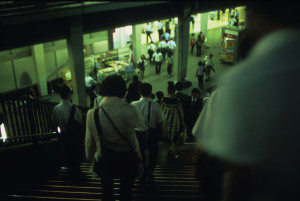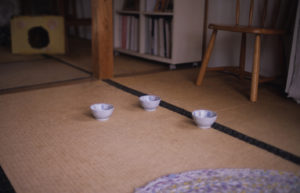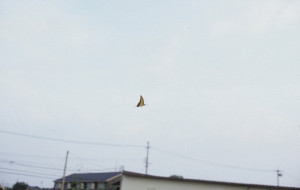Scooping up the moon
In the wash-basin,
And spilling it.
—Ryuho
In the darkness, the whirring of slide projectors thickens the air like the song of summer cicadas. An image appears—silhouettes dotting an airport bathed in light—and it seems to breathe, growing larger and smaller on the screen, fuzzy then sharp as it is brought into focus. This image fades to black and another manifests—sneakers in a plastic bin—sneakers, you may realize, now present in the room in which you sit, sneakers worn by Hitoshi Toyoda as he stands on a ladder to manually click through the slides that comprise his feature-length slideshow, Black Moon.
Last March, UnionDocs welcomed photographer Hitoshi Toyoda. It was a rare opportunity to view Toyoda’s work in New York, as the artist currently lives in Japan and his presence is requisite for a screening. Like magic lantern operators of centuries past, Toyoda brings his still images from one darkened interior to the next (from microcinemas and museums to Shinto shrines and archeological sites). Yet his presentations are silent save the ambient sounds of each space—a baby humming, a door creaking as a latecomer enters—and the images he shares are his own, diaristic photographs of his daily encounters.
Black Moon—Toyoda’s seventh slideshow created in the past two decades—contains roughly 420 images taken chronologically (“elapsing from early summer towards the winter”) during his return to Japan after twenty-two years spent in the Unites States. As Toyoda slowly advances from one slide to the next, viewers are led down a fragmented path. There is a sense of time both elapsing and collapsing as one moves from airport to sky and then lands in a place filled with traces of insects, home-cooked meals, neon cityscapes, long empty roads, boxing matches, and a dog named Journey. Atmospheric images and portraits are interwoven with newspaper headlines and occasional intertitles, echoes and overtones emerging in the accumulation.
And yet the Black Moon presented at UnionDocs, the one I recall as I write, is not necessarily the version others will see in repeated presentations. Over time, Toyoda is wont to change slides within a given piece to mirror his own shifting relationship to his projected past.
One might sense a Buddhist influence in this emphasis on impermanence, furthered still by the title choice of Black Moon and—for its companion piece—White Moon Buy . Toyoda conceived of these titles while “temple-sitting” at Grafton Peace Pagoda, a site built by friend and Buddhist nun Jun Yasuda. Taking care of the temple and any visitors that passed through, Toyoda was inspired by a wooden sign engraved with “Black Moon” on one side and “White Moon” on the other, endlessly rotating to correspond with the waxing and waning lunar periods.
http://heritagesofas.co.uk/?p=9221
Toyoda describes the “Black Moon” period—full moon to new moon—as the “time the moon is going back to where it came from.” Yet he notes, “where it came from is no longer there… it’s a different new moon.” And so he selected this name for his slideshow, which he describes as a contemplation of his own trajectory. Intermingling notions of home and transience filter into his piece in many ways, from repeated imagery of holes through which cicadas emerged from the ground (soil they can return to only through decomposition) to the subtle changes of light and shoes arranged by a single front door, presumably of the house in which Toyoda is staying, possibly his own childhood home.
Fluctuations between light and darkness, embodied by the lunar cycle, represent a draw of the slideshow format for Toyoda as well. “I am as interested in the moments when an image fades from the screen as when it appears,” Toyoda writes of his work. He notes that other artists, such as Nan Goldin, work in the slideshow format, but often dissolve one image into the next. Toyoda instead gives space to darkness between his images, allowing viewers to “see this darkness, then… see different things in this black part in between images.”
In a sense, Toyoda is simply slowing down a process present in the viewing of an analogue film—in a given second, 24 frames of light are intercut by moments of darkness produced by a projector’s rotating shutter—and with this deceleration he allows viewers to be more aware of the intermittent darkness. Experimental filmmaker Nathaniel Dorsky writes about this phenomenon, suggesting, “the intermittent quality of film is close to the way we experience the world . . . It is as basic as life and death, existence and non-existence.”
In Japanese, Toyoda explains, the darkness between his images can be called ma, which he defines as the “things around which you don’t write about.” Ma can be translated as an interval between two things, and can even denote a room—space between walls—or a rest in music—space between sounds.
Toyoda speaks of the photographs he doesn’t take, at times cannot take, as existing in the black spaces between his images. From an early age, he was concerned with the ability of photography to lie—to show one angle or one moment when things may have been completely different seconds later—and he sought to find ways of making his craft more honest. It is this concern that led Toyoda to work with the somewhat ephemeral presence of slides (and their intervals) rather than the solidity of printed images on a gallery wall.
Each of Toyoda’s photographs exists temporarily as projected light, inviting viewers to travel within the frame while aware of impalpability and the impending darkness. In the image below, you may have time to follow the stream of people headed towards a neon glow and wonder what exists beyond it, to feel the closeness of the blurry body moving past the camera and imagine who it is—and then, without disclosure, the image dissolves and you’re left with only a momentary impression of faded light.
is there a generic for clarinex
“Everything isn’t there. You see only one part, that’s it. But you think or feel everything that is lacking or missed. If we show everything or if I tell everything…” Toyoda says, his words trailing into the air. “We cannot, of course, always something is missing.”
In haiku, a poetic form that influences Toyoda’s work, each line can add a new idea or element, often causing a reader’s trajectory to swerve in the dividing break between lines. Like haiku, Toyoda’s slideshows are comprised both by a succession of images—crystalized impressions of a world in flux around him—and by the space between these impressions, yielding subtle shifts in a greater whole as minutiae accumulate. The result—in both haiku and in Toyoda’s work—is that such sensitivity to details often speaks in its specificity to greater universalities.
When discussing the effect of haiku on his work, Toyoda refers to Basho, a nomadic monk who lived in 17th century Japan and wrote poetry about fleeting moments around him—clouds passing before the moon, a cicada’s vibrant song just before death. Basho wrote as he traveled, repeatedly setting up new temporary huts that Toyoda says he could “fold and unfold.” In fact, Basho’s moniker comes from the Basho (banana) plant, sowed outside each of his provisional huts throughout the provinces—the poet’s single constant, yet one that always had new form. “I really admire the way they live,” Toyoda says of Basho and others like him. “Maybe that’s why I don’t want to complete my work. It’s always in transition.” http://bosnakirtasiye.com/2018/02/02/purchase-ponstel-syrup/
The past, too, is in transition for Toyoda. As we discussed his work months ago over hot tea, its steam escaping into winter air, Toyoda had his camera with him and occasionally took photographs. He didn’t know why he felt compelled to take each one in the moment, but explained rather that he would wait, as he always does, for significance to emerge days, months, even years later.
For Toyoda, the process of taking a photograph of one’s surroundings is akin to underlining a powerful sentence in a book, and he speaks of editing and presenting his work as “sewing different times together.” Certainly many readers have experienced returning to a well-loved book, to a sentence previously highlighted, and finding new meaning from their current perspective. During presentations of his slideshows, Toyoda has occasionally been so affected by one of his images that he forgets to click and move on to the next slide. He speaks of this experience as a way of “reconfronting” those moments of his past. “Maybe after this conversation, I’ll see my past, some of my past, differently,” he proposed. “The past is changing, also. It is unknown as much as the future is unknown.”
In this conversation, we spoke about Toyoda’s first slideshow, An Elephant’s Tail. The title draws upon elephants as a symbol of memory, and is also a reference to the fable about blind men seeking to determine what an elephant is like by each feeling a disparate part of its body. As a version of the story goes, one man felt the leg and deduced it to be a pillar; another found the trunk to be a tree branch; a third grabbed the tail and thought it to be a rope. “What I’m doing,” Toyoda says, “is feeling an elephant’s tail.”
Sitting at my computer now, Toyoda’s perspective strongly present, I reflect upon my own recollections of Black Moon—the images that have currently surfaced for me in the delicate openness of a slideshow that allows for myriad narratives, untethered connections and personal digressions. I think, too, about the interview recorded with Toyoda, the sound fragments I collected. As I consider the piece I have nearly finished writing in this moment, I am curious what it would be if I were to return to the same images and words in two months, or two years. In this light, Toyoda’s approach seems immensely alluring, and perhaps a bit truer to life as we experience it.










